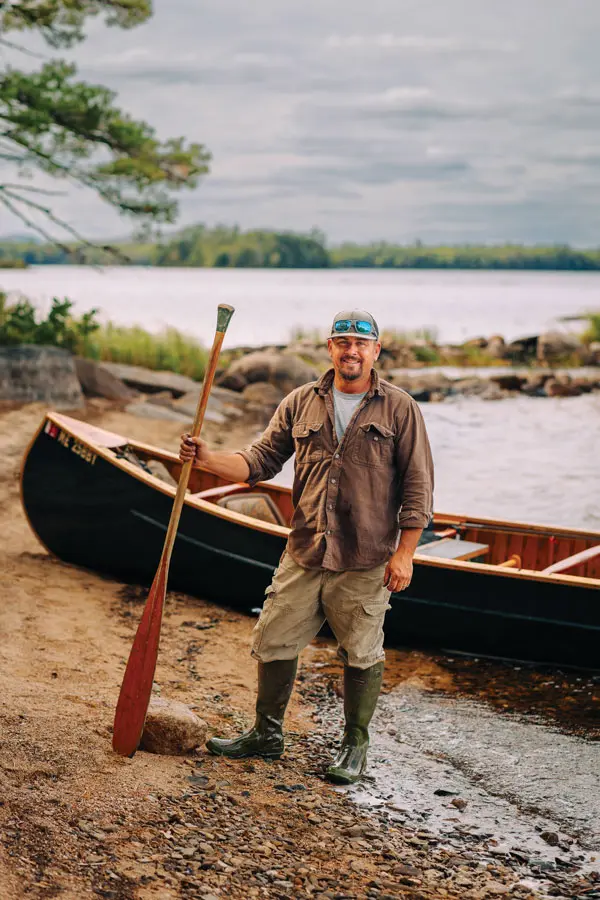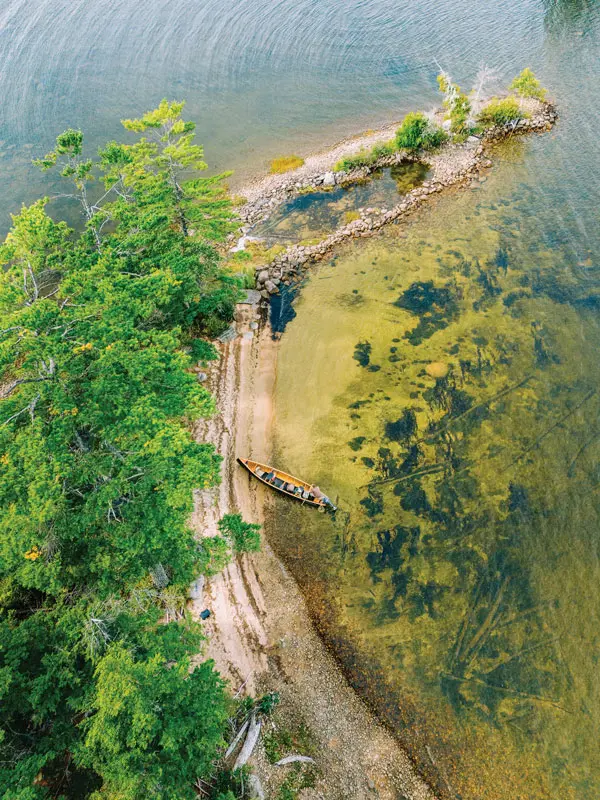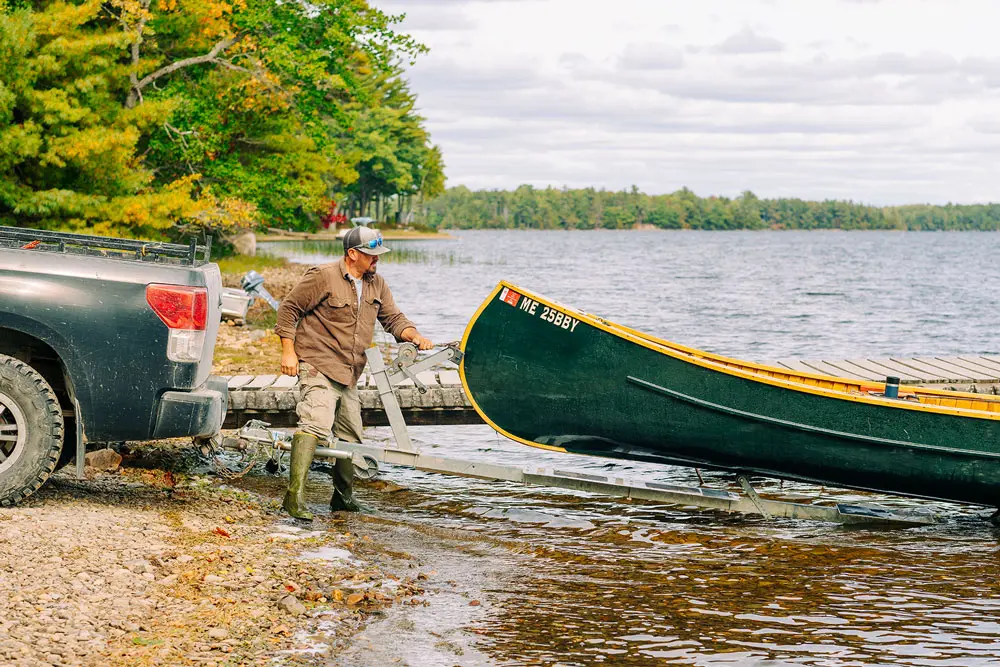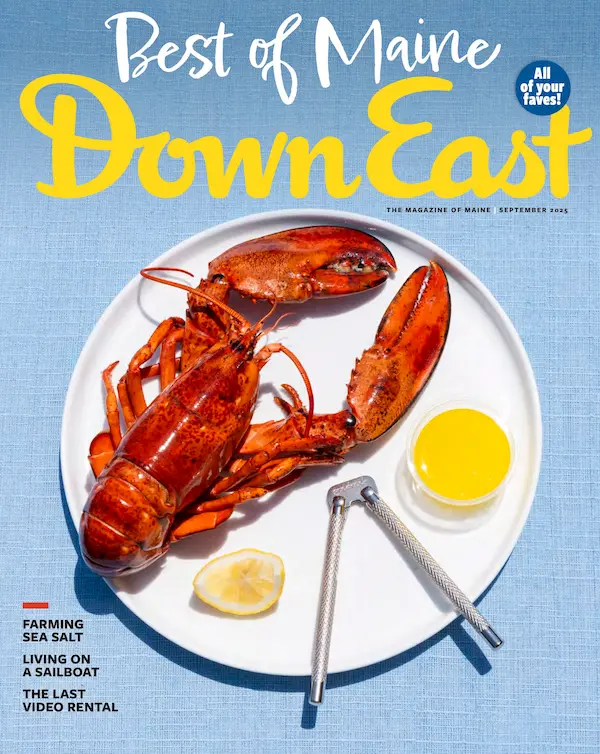By Michele Christle
Photos by Mat Trogner
From our June 2025 issue
Canoeing has been intrinsic to life down east for a long while. This is especially true around Grand Lake Stream Plantation, in Washington County, where a sparkling-blue chain of lakes wends its way along evergreen shores. For 13,000 years, give or take, the Passamaquoddy have paddled the local waterways, and one of their villages was at the south end of West Grand Lake, near where there’s now a dam and a general store. It was a seasonal hub for the tribe, a place for harvesting runs of fish and hunting caribou and deer.
With the arrival of white settlers, the Passamaquoddy increasingly lost access to their traditional lands and waters. In the early 1800s, logging got to be big business around Grand Lake Stream, with lumber camps strewn throughout the forest and trees felled in great swaths. Later that century, a tannery started processing hides shipped from all over the world — the American West, Brazil, China, Zanzibar. For a time, the tannery was the largest in the world, and the town often stank of rotting hides. “Work, smell, and confusion were ever-present realities,” one local historian wrote in 1920, two decades after mismanagement, a fire, and broader economic forces conspired to shutter the business.
That tannery, though, is what first brought a member of the Bacon family — James, a blacksmith — to the area. And despite the harm not just from logging, tanning, and damming, the environment was resilient and fish populations, aided by a salmon hatchery the federal government established in 1875, kept one economic lifeline open, attracting sportsmen to the area from elsewhere along the East Coast. While most residents left Grand Lake Stream after the tannery closed, many of those who remained, inspired by the Passamaquoddy hunting and fishing guides who’d been hosting sportsmen since the early 1800s, turned to guiding, including James Bacon’s son, Herbert, better known as “Beaver.”
The local corps of Registered Maine Guides — the state began requiring guide certification in 1897 — counted men of European descent as well as several members of the Passamaquoddy tribe among their ranks. Their clientele was largely urban and affluent and, over the years, included the likes of President Warren Harding, Ted Williams, and Joe DiMaggio. Canoes were the vessel of choice for fishing expeditions, and in the early 1900s, their hulls were still usually made of birch bark, in keeping with age-old Passamaquoddy practice, or canvas. (Logging and disease, though, had stripped the woods of the big birches needed for the former.)



Then, in the 1920s, someone showed up in town with a curious new bit of technology, an outboard motor, and that gave Beaver Bacon an idea. Typical canoes are double-enders, tapering to two points, elegantly symmetrical. Beaver drew up a design for a wooden canoe — heavier than bark or canvas — that looked as if one end had been sawed off and boarded up flat. On that square stern, an outboard motor could be mounted. The advantages were obvious: guides would be able to shuttle swiftly around lakes, hitting multiple fishing spots without needing to paddle great distances or catch a steamboat ferry. So obvious were they, in fact, that at least a few other Grand Lake Stream guides built similar canoes around the same time, and the matter of who completed one first is seemingly lost to history. In any event, Beaver was in the vanguard, and the style of canoe that became known as the Grand Laker had been born. Quickly, it turned into the area’s preeminent guiding boat.
“This is still something, you know? One hundred years later and not much has changed.”
Nowadays, Nate Bacon and his dad, Jeff, meet up at 8 a.m. every weekday all through the winter at Jeff’s barn, in Hampden, a couple of hours west of Grand Lake Stream. They flip on the lights, get the woodstove going, and tune the radio to a rock station. Sometimes, they find themselves whistling along in unison as they get to work on Grand Lakers, repairing old ones and building new ones. They represent some of the last builders of the canoes, a craft passed down to them through the generations.
When Beaver started getting up in years, his son, Timmy, became his understudy. A slender, short man who preferred to work alone (and who, like his descendants, was also liable to whistle while working), Timmy averaged 10 Grand Lakers a winter and spent summers guiding. His acrobatic prowess was legendary. With a mouth full of brass tacks, he’d pull a hot rib of cedar from the steamer, spit out a tack, hammer it in on the inside gunwale, hop over the mold to clinch it on the outside, and then scramble back over to repeat the maneuver.








Nate Bacon’s Grand Lake Stream guiding service is Daybreak Adventures. He takes customers fishing for salmon, bass, and trout, and he cooks up hearty lunches on the lakeshore. Off the water, he also leads hunting expeditions for grouse and woodcock.
Canoe building, though, skipped the next generation. Timmy’s son, Greg, grew up helping out in the shop, but he never felt the urge to make Grand Lakers himself. Family lore has it that if he skipped school (which was hard to get to in those days — a long trip over bad roads, Jeff notes), Timmy would have him work on canoes instead, making time in the shop feel a bit like a punishment. Greg left Grand Lake Stream in the 1950s, spent time in the military, found work as a trucker, and eventually settled near Hampden.
Jeff, Greg’s son, had the itch his father never had: he wanted to try his hand at building Grand Lakers. Still, everyone told him there was no money in it, and he wound up starting an auto-parts business instead.

Nate was only eight when Timmy died. After that, Timmy’s Grand Lake Stream home and workshop were sold, but Nate felt pulled back there. His family kept a camp and returned every summer. Almost 20 years passed between the last canoe Timmy built, in 1988, and the first one Nate built, in 2007. He and Jeff had Timmy’s last canoe, still unfinished, and Nate was a carpenter. Studying that boat provided a glimpse into the construction process. The idea at the time wasn’t to start a business — it was just something Nate wanted to do.
A couple of years later, he got his guiding license, becoming the fourth Bacon to guide fishing trips in those waters. He took his clients out in the Grand Laker he had built. And the more he guided, the more potential he saw in bringing boatbuilding back into the family. Clients who enjoyed being whisked around in his Grand Laker started asking about how to get one for themselves.
Individually, neither guiding nor canoe building would bring in enough money to constitute a living, but Nate thought the two pursuits could go hand in hand. (“There’s that saying, ‘I’ve never seen a rich fishing guide, but I’ve never seen a mad fishing guide either,’” he notes.) At first, Jeff would join Nate in the workshop only on weekends, but in 2017, Jeff sold his auto-parts business to devote more time to building canoes alongside Nate.
Working in Jeff’s barn, the father-son duo have developed a division of labor more orderly than Timmy’s one-man acrobatics. Nate does the outer hammering and Jeff does the inner clinching, and neither has to jump about. They do, however, move about the shop with mouthfuls of tacks, and many of the tools they use are family heirlooms: Timmy’s old hammer, the steam box, the sawhorses. The canoes they make today are pretty much the canoes Beaver started making a century ago, employing a few more modern tools and materials, like a skill saw and epoxy. (“You caught us!” Nate jokes.) A few years ago, Nate and Jeff created a new, bigger mold, designed to accommodate a heavier motor and carry more weight, but they’ve kept it all to scale and as close to Beaver’s original as possible.
For the most part, there are four Grand Laker molds, named for their designers: the Bacon, the Wheaton, the Pop Moore, and the Sprague. Nate says that most people will, at a glance, think all look the same, but if you pay close attention, you’ll notice the curve and the bows are a bit different. Beaver and Timmy’s canoes always had a slightly beveled edge on each of the tapered ribs, rather than a rounded edge. Now, so do Nate and Jeff’s.
Nate and his dad, Jeff, use Jeff’s barn, in Hampden, as the workshop for Bacon Built Woodworks and Canoes.
Timmy used to make about 10 canoes every winter. These days, Jeff and Nate average two or three, in addition to fixing up eight to 10 older ones. “To do 10 of them a winter, that’s a champion,” Jeff says. A new Grand Laker takes them between 100 and 120 hours to build and start at $7,000.
In recent years, Downeast Lakes Land Trust has bought up and preserved almost 60,000 acres around West Grand Lake. Nate goes out in those woods every spring with Grand Lake Stream’s other remaining Grand Laker canoe builder, Dale Tobey, who has a harvesting permit from the land trust. Together, they fell ash trees they picked out while hunting in the fall. Those trees will become the decks, outer gunwales, and thwarts. A few small lumberyards in the area set aside cedar for the ribs and planks, just as they used to do for Timmy and the other builders.
Nate talks with reverence about guiding and being on the water. The sight of Grand Lakers heading out on trips is a continuing source of happiness for him, and many guides in the area continue to insist on Grand Lakers over modern motorboats. Jeff’s best guess is that there are 200 to 250 of the canoes in the area around Grand Lake Stream, even though they never really caught on more widely. “This is still something, you know?” Nate says. “When I see a bunch of Grand Lakers going up lake in the morning or I’m chugging up lake with a couple people going fishing or going to have lunch at a lunch site my great-grandfather built, I think, ‘How cool is that?’ We’re still doing this. One hundred years later and not much has changed.”
A few years ago, Nate was guiding a couple from New York City. It was a flat, calm morning. “These people were talking, talking, talking,” Nate says. “After a few minutes, I said, ‘Did you hear that?’ They looked around, waiting for something to make a noise. I said, ‘Shhh.’ They’re like, ‘What?’ I said, ‘It’s nothing.’ They said, ‘We haven’t heard nothing before!’ It’s wicked busy in the summertime, with all of us guides running around, showing people the quiet world.”
The Grand Lake Stream Historical Society Museum is tucked down a narrow, leafy lane near the center of town (where all the street signs are shaped like canoes), and it includes a new building called the Guides Gallery. Inside, three of the walls are covered in photo portraits of guides, and one wall remains empty. Though the Grand Lake Stream Guide Association has more than 30 current members, none of them are in the museum yet. “You’re not lucky enough to get your picture on the wall until you die,” historical society president Mike Brunner explains.
That sense of history pervades the place, and Jeff and Nate are increasingly keen to be in Grand Lake Stream year-round. Jeff is working on a four-season cabin, and Nate and his family are looking for a house to buy. For them, it’s not just about living there — it’s about returning the molds, the tools, and the canoe shop itself to where it all began. “We’ve got to get them back where they’re supposed to be built,” Nate says.
When the new owner of Timmy’s house moved in, he found one of Timmy’s old shirts lying around and returned it to Nate — a Johnson Woolen Mills jac shirt, black-and-white buffalo plaid. Timmy would throw it on to go back and forth between the house and the shop. Now, it’s hanging on a wall at the family camp. Jeff and his wife, Trudy, recently bought Nate a new shirt with the same colors and from the same company — one that’s a little more his size. Nate brings that shirt out in the canoe with him every day he guides.










